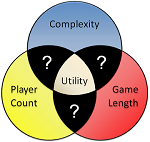 We’ve got some extra-special topics on deck this month but first a quick re-introduction to where we left off. Earlier this year we introduced the first phase of our framework we call “dimensions of games”. Our initial three attributes you’re probably familiar with as they contribute to the label on the side of every game box: Complexity, Player Count and Game Length.
We’ve got some extra-special topics on deck this month but first a quick re-introduction to where we left off. Earlier this year we introduced the first phase of our framework we call “dimensions of games”. Our initial three attributes you’re probably familiar with as they contribute to the label on the side of every game box: Complexity, Player Count and Game Length.
We concluded with the concept of Utility which is how the aforementioned attributes combine to form the situational value of a game. Naturally some games are easier to get to the table as they are easier to explain to a new group, can fit into a limited time frame or accommodate a wide number of player counts.
Complexity, Player Count and Game Length each allow a game designer control over the intended experience. A designer may start with a design goal of a game that scales well between two and six players or packs a lot of interesting elements into a one hour playing time.
Dimensions of Games Phase II
This month we’re exploring the intersections of these attributes which are interesting topics also under the control of game designers.These are some key elements we’ll cover one by one in the coming weeks. Let’s get a visual:

Downtime (Player Count ∩ Game Length)
Downtime can be simply described as the periods of inactivity during a game. We’ve all probably played in a few games that seem to drag between turns or maybe are prone to bring out indecisiveness out of anyone. Two driving factors of downtime are how a game scales (perhaps observing changes in game play from adding another player) and how time is allocated in a game (the structure of turns and the weight of decisions).

Key Questions for Downtime:
How can downtime be utilized effectively?
What should be asked of players at any given moment in a game?
How can downtime be transitioned from a weakness into an asset in game design?
Pacing (Complexity ∩ Game Length)
One of my favorite topics in games simply because it almost never comes up for a thorough discussion, at least in a manner useful to tabletop games. This month we’re going to look at the ebb and flow of games, how pacing can mean the difference between a good game and a great game and the benefits of several different types of pacing. Generally the intended length and structure of a game contribute to the level of pacing we see in games.

Key Questions for Pacing:
How do the decision variables change over the course of the game?
How can games create a natural progression to a game that feels rewarding to players?
How are players able to anticipate key events including triggering end game conditions?
Player Control (Player Count ∩ Complexity)
We’re going to have to end on a bit of a cliffhanger but we’ve been working on a topic that one that will work best once we provide the write-up with its full context. Using the convergence of player count and complexity we’re going to take a look at a specific subset of player interaction; player control. Player control loosely evaluates how player ability translates to performance under various circumstances. The real value in this topic will come from a player perspective – we’re going to look at things that frustrate players that may not fall under the microscope for game designers.
Key Questions for Player Control:
How do the value of various strategies change with different player counts?
What thresholds exist which can cause a game to suddenly feel out of control?
What causes a player’s influence to diminish in a game and how can that be improved?
In the meantime please continue sending us your game design thoughts and questions, we’re putting together a special mailbag next month with many of the entertaining (and unexpected!) reader responses we’ve gotten over the past year. We’d love to include your intriguing questions, humor and feedback about anything we’ve written about this year.




Valuable information. Thank You.
You’re very welcome Larous. Thanks for reading!